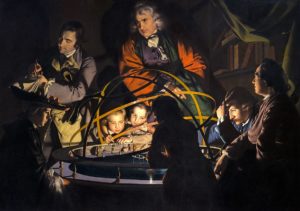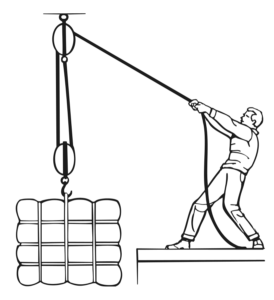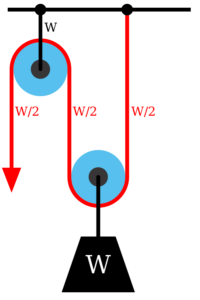 Also invented at this time (though some people think it was later) was the shadoof (shu-DOOF), which was a counter-weighted lever and bucket. These interesting devices allowed people (especially old and young people who weren’t terribly strong) to pull water from streams, lakes and wells. Water, of course, is fairly heavy, weighing more than eight pounds per gallon.
Also invented at this time (though some people think it was later) was the shadoof (shu-DOOF), which was a counter-weighted lever and bucket. These interesting devices allowed people (especially old and young people who weren’t terribly strong) to pull water from streams, lakes and wells. Water, of course, is fairly heavy, weighing more than eight pounds per gallon.
Here, to help understand these devices, is an old photo of one:
 One thing that we don’t have evidence of during the ice age is the wheel. People of that time clearly had the lever, the wedge and the inclined plane, but it we don’t find wheels, even though they moved heavy things by rolling them on top of logs. Wheels seem to have come along during the Mesopotamian period, before or at the formation of the Sumerian empires; perhaps at 4,500 BC or a bit earlier, and perhaps beginning with potter’s wheels.
One thing that we don’t have evidence of during the ice age is the wheel. People of that time clearly had the lever, the wedge and the inclined plane, but it we don’t find wheels, even though they moved heavy things by rolling them on top of logs. Wheels seem to have come along during the Mesopotamian period, before or at the formation of the Sumerian empires; perhaps at 4,500 BC or a bit earlier, and perhaps beginning with potter’s wheels.
People also knew how to dig wells for water in those days, but how far back is hard to tell. They also knew how to recognize poisonous foods and to test new foods to be sure they were safe. They almost certainly used certain plants for medicine.
By the time of Catalhoyuk (which we discussed in Lesson 1), people were producing a great deal of art, and specifically geometric art. They were also using mirrors, jewelry, and perhaps currency, in the form of obsidian. All of these were important new technologies, and all made their lives more pleasant or their labors more effective.
What Technology Wrought
What technology produced by the time Europe was filled with agriculture – what it wrought for us – was a solid and comfortable lifestyle. By that time, having enough to eat wasn’t too much of an obstacle: we knew how to grow and process plenty of it. Bad weather could still make problems, but long distance trading eliminated a lot of shortages, and nearly everyone knew how to fish and hunt quite well.
We also knew how to cooperate. And we had time enough to look after our inner needs.
Circumstances required us to live in families and to divide our work (roughly) between “men’s work” and “women’s work,” but it was an efficient set of arrangements, and arrangements that most people liked anyway.
In short, our species had found a stable way of life that served as a base for further progress. This, moreover, was a very un-regimented time. In fact, more or less all the technologies we’ve mentioned thus far were in place before people were regimented by rulership. Progress came first, regimentation came after.
It’s also interesting that people of this time were very clear on the fact that they stood above any other type of creature on our planet: they knew were better than animals and had no problem saying so. In fact, any thought to the contrary would be something they’d laugh at: Animals were nowhere remotely equal to us; we were creatures of a massively better type. (We still are, of course.)
From That Base…
The base of technologies we’re referring to here is primarily the one that spread from Anatolia at 7,000 BC, all the way across to Ireland, where it arrived by about 4,000 BC. And what it gave to all the people of that area was a life of stability and options. People were growing and raising more than enough food, they were cooperating well, and they were using their free time to invent and improve things.
And again, this was before rulership drew people into regimentation and took their surplus production from them.
It was during these years that people developed most of the things we discussed in previous lessons: Smelting metals, inventing much better sailing vessels, creating potter’s wheels, and so on.
Another major invention from this period was charcoal. Charcoal burns much hotter than wood, and that extra heat was necessary for smelting metals. At some point (and we don’t really know when), people learned that they could heat up wood, but without letting it burn, and that all the water in the wood would come out, and that the left-over charcoal would burn much hotter.
Charcoal was usually made from large piles of wood that were covered with enough earth to prevent an outright fire. This had to be done carefully, but humans are clever, and they soon enough perfected the process. Charcoal production usually ended up as a family business, and here’s a photo of a family charcoal operation from about 1890 AD:
 Inventions continued steadily, of course, whether human lives were regimented or not, and a long string of new discoveries followed: pulleys, block-and-tackle lifting machines, water wheels, water pumps, trusses (which made large buildings possible) and glass.
Inventions continued steadily, of course, whether human lives were regimented or not, and a long string of new discoveries followed: pulleys, block-and-tackle lifting machines, water wheels, water pumps, trusses (which made large buildings possible) and glass.
Below is a block-and-tackle arrangement that allows someone to lift 100 pounds while only pulling 50 pounds on a rope. Over time, this discovery was expanded to make machines like cranes, able to lift tremendously heavy things.


And here’s a basic water wheel design, using the weight of water to turn a wheel that will be used to perform work:

**
Paul Rosenberg
freemansperspective.com
